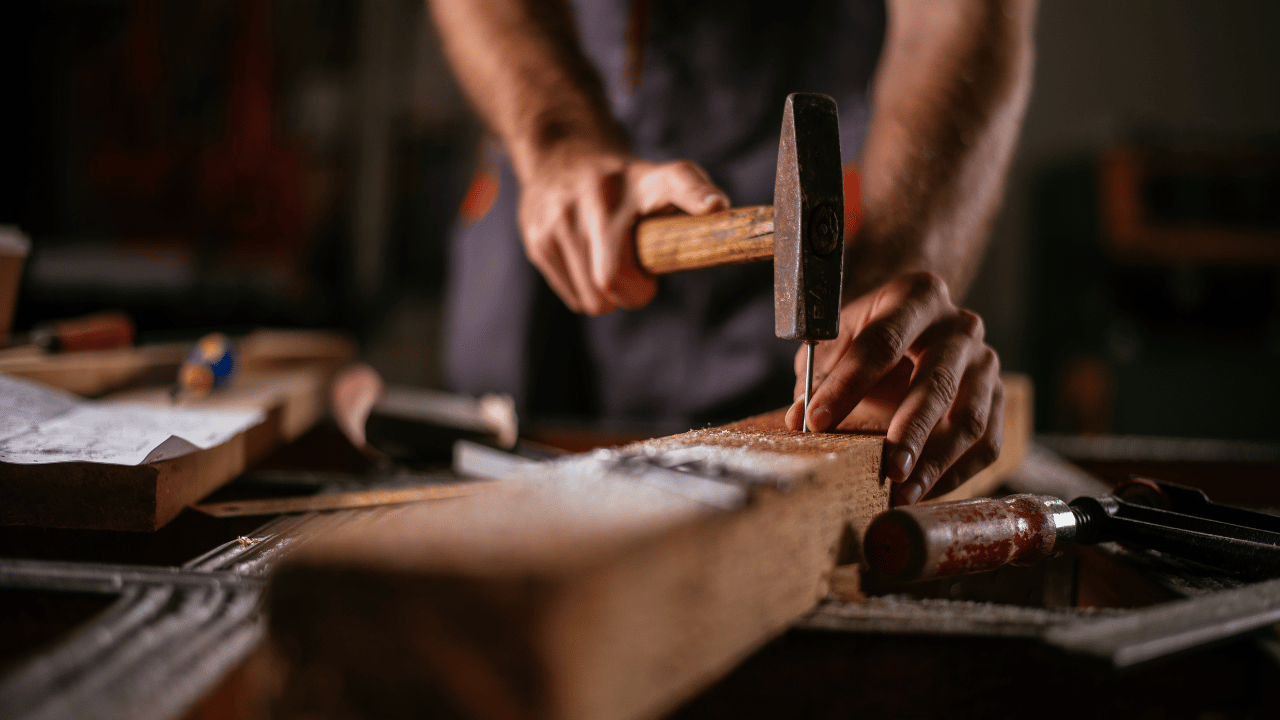Last Updated on October 21, 2023 by Pro Handyman Australia – Editorial Team
If you’re keen on constructing something innovative and valuable, you’re in the right place. Embarking on these projects doesn’t demand access to a comprehensive workshop or extensive woodworking expertise. All you’ll need are some basic tools, a dash of determination, and a reliable Carpentry Skills Checklist to guide you.
Instead of overwhelming yourself with intricate designs, it’s advantageous to begin with projects that highlight the foundational aspects of building. By doing so, you’ll gradually refine your skills, laying down a solid base for more complex endeavors in the future.
Remember, with just a few common tools at your disposal and a willingness to put in the effort, you can accomplish these projects. The key is to leverage what you already have, infusing every task with dedication and meticulous attention to detail.
So, don’t hesitate. Embark on this journey of creating something beautiful and functional. Your crafted pieces will not only serve practical purposes but also stand as a testament to your growing craftsmanship.

Crafting a Wooden Chopping Board and Serving Tray
Preparing the Perfect Chopping Board
Craft a stylish chopping board that’s both functional and aesthetically pleasing. A straightforward technique involves dry-fitting the components, sketching the arc, and assembling everything securely. A steel ruler measuring 4-ft. can be a reliable tool for drawing the arcs, but alternatives like yardsticks or thin boards can be just as effective.
Key Tips for Maintenance
To ensure longevity, it’s essential to utilize water-resistant wood glue during the assembly process. Be cautious about exposing your board to excessive moisture: avoid dishwashers as they can cause the board to deteriorate. Moreover, maintaining evenness among the boards during the gluing process will reduce the effort needed for sanding later on.
The Shoe Storage Booster Stool

Crafting a Multipurpose Stool
A functional stool can be both a shoe storage unit and a step to access higher shelves. In just an hour, you can craft this versatile piece using a 4 ft. x 4 ft. sheet of 3/4-in. plywood, wood glue, and several 8d finish nails. After cutting the plywood as illustrated, apply wood glue at the joints and assemble the pieces using nails. This assembly ensures a robust structure, enhancing the stool’s durability.
Building an Affordable Wooden Bench
Simple Seating Solution
If you’re in need of additional seating and pressed for time, a simple wooden bench can be the answer. Based on a timeless design, even novice woodworkers can craft this bench in mere hours. The materials are minimal: just two boards and 18 screws.
Streamlined Magazine Storage Solutions
Creating Handy Storage Bins
To organize and store magazines or essential papers, craft wooden storage bins. You can make four bins using a 2 ft. x 4 ft. sheet of 1/4-in. plywood and two 6-ft. long 1x4s. These bins ensure that your reading materials are easily accessible and not just lost in a towering stack.
Elegant Coat and Hat Rack
Decluttering Your Entryway
An hour is all it takes to craft a minimalist coat and hat rack that helps declutter your entryway. Using a 6 ft. 1×4 and a selection of coat hooks, cut the boards to your desired length, paint them, attach your chosen hooks, and mount them to your wall. A variety of hook styles and colors are available at hardware stores, allowing customization to match your decor.
Designing a Practical Spice Rack
A Spinning Spice Solution
Craft a rotating spice rack that keeps 18 of your favorite seasonings within arm’s reach. The assembly process is detailed and fun. For this project, gather the following:
- Wood discs measuring 11-1/2 in. and 7-1/4 in. in diameter.
- Lazy Susan hardware measuring 9-in.
- Four 1-5/8 in. x 5/8 in. dowels for legs and one 5-1/4 in. x 5/8 in. dowel handle.
- Specific drill bits including a 1-7/8 in. Forstner bit and a 5/8-in. spade or brad point bit.
- A wood ball or a different knob for the handle.
After marking and drilling the necessary holes on the discs, assemble them using the dowels. Add a finish to match your interior, and you’ll have a spinning spice storage solution.
Efficient Pantry Storage Saver
Optimizing Spice Storage
For those struggling with overcrowded spice drawers, this efficient rack is the remedy. Made from leftover 1/4-in. and 1/2-in. plywood, this design easily fits into drawers. Depending on your storage needs, you can also opt for a two-tiered version.
Nature-inspired Tree Branch Shelf
Infusing Nature into Your Decor
Introduce a touch of nature into your living space with a rustic branch-supported shelf. Locate two forked branches with a diameter around one inch. Ensure one side of each branch is reasonably straight so it can sit flush against the wall, and then proceed with mounting the shelf.
Crafting a Simple Knife Block

Efficient Knife Storage
This elegant knife block, which also incorporates a 6-in. wide storage space for a sharpener, is both straightforward to construct and visually appealing. The primary materials are a 3/4-in. x 8-in. x 4-ft. hardwood board and a matching 6-in. x 6-1/2-in. piece of 1/4-in. hardwood plywood.
Start by segmenting the board, followed by making cuts for the knife slots. Carefully assemble the components, ensuring that the glue doesn’t obstruct the slots. Complete the block by adding a lid with a finger pull and finish the wood for a polished look.
Crafting a Simple Step Stool
Looking for a functional gift that’s bound to impress? Construct a straightforward step stool. The joints for this project can be made quickly using a plate jointer, ensuring precision and durability. You’ll also need a power saw for crosscutting the boards and a jigsaw for crafting the half-circles in the risers.
Optimizing Space with Behind-the-Door Shelves
Unlock the hidden storage potential behind your doors. A set of shallow shelves affixed to the wall can do wonders for decluttering. The best part? The required materials might already be in your scrap pile, including some framing steel studs. Start by identifying the wall studs. Once located, drill clearance holes and affix the shelves using 2-1/2-in. wood screws. For added protection, consider placing a rubber bumper on the frame to shield the door. If you’re unsure about stud locations, consider investing in an electronic stud finder.
Designing a Compact Ironing Center
Streamline your laundry process with a dedicated ironing center. This is a two-hour project which only requires a 10-ft. 1×8, a 2-ft. piece of 1×6 for the shelves, and a pair of hooks for the ironing board. Begin by cutting the required pieces. To add a touch of flair, consider crafting a 1 in. x 1 in. dog ear at the bottom sides. Glue and nail the pieces together in stages for better precision, ensuring the shelves are firmly secured. Once assembled, give it a fresh coat of paint or stain. For mounting, drill pilot holes and use screw-in wall anchors for sturdiness.
Constructing a Stacked Recycling Tower

Transform your recycling routine with a structured tower that’s both space-saving and organized. This project primarily requires five plastic containers, six 2x2s, screws, and just about an hour of your time. To ensure fit, our design specifically accommodates containers with a top measuring 14-1/2 in. x 10 in. and a height of 15 inches. Adjustments can be made based on the containers you have on hand.
Begin by cutting the 2x2s as per the project’s dimensions. Mark positions of the rungs on the uprights, drill the holes, and secure using 2-1/2 in. screws. Assemble the front and back frames before joining them with the side crosspieces. Need to maximize garage space further? Consider combining this tower with other storage solutions.
Understanding the Importance of Knowing the Simple and Essential Woodworking Tasks
The world of woodworking is vast and profound, with an intricate tapestry woven from its historical significance, cultural implications, and the sheer beauty of its creations. Before diving deep into this ocean of craftsmanship, it’s crucial to understand and master its essentials. Like a budding pianist practicing scales or a young chef mastering knife skills, recognizing and practicing the essential woodworking tasks forms the base for all future carpentry endeavors.

1. Woodworking and Its Significance
Historical Importance
Woodworking dates back thousands of years. From the earliest wooden tools to grandiose architectural marvels, wood has been a constant companion in humanity’s evolutionary journey. Ancient civilizations like the Egyptians, Greeks, and Chinese have rich carpentry heritages, which have paved the way for modern techniques.
Cultural Relevance
Beyond utility, woodworking stands as a reflection of a culture’s artistic sensibilities, priorities, and innovations. The ornate wooden carvings of Indonesian temples or the minimalistic wooden furniture of Scandinavian designs echo cultural ethos and aesthetics.
2. Basic Woodworking Tools and Their Uses
Before we delve into tasks, understanding the tools is paramount:
- Measuring Tools: The saying, “measure twice, cut once,” underscores the importance of rulers, measuring tapes, and calipers.
- Cutting Tools: Saws, chisels, and knives are fundamental for any woodworking project.
- Joining Tools: Hammers, nails, screws, and wood glue help in binding pieces together.
- Finishing Tools: Sanders, planers, and wood finishes give the final touch, enhancing the product’s aesthetics and durability.
3. Essential Woodworking Tasks: The Basics
Measuring and Marking
Accuracy is paramount. Properly measuring and marking wood ensures that cuts are precise, resulting in seamless joints and a polished final product.
Cutting and Shaping
Mastering straight and angled cuts using different saws, including understanding what is a jigsaw and its unique capabilities, forms the backbone of woodworking. Beyond that, shaping, which encompasses techniques like carving, turning, and planing, allows for greater intricacy in design.
Joining and Assembling
This involves the skillful art of bringing separate wood pieces together. Techniques such as doweling, mortise and tenon joints, and dovetailing are fundamental joining methods every woodworker should acquaint themselves with.
Finishing
Applying finishes protects and accentuates the wood’s natural beauty. This task encompasses sanding for smoothness, staining for color, and sealing to protect against wear and tear.
4. The Importance of Mastering the Essentials

Building a Solid Foundation
Just as a house requires a solid foundation, so does a woodworker’s skill set. By mastering the basics, you ensure that more advanced tasks are achievable and are of high quality.
Avoiding Common Mistakes
Understanding essential tasks helps in averting common pitfalls, saving both time and resources.
Enhancing Efficiency and Creativity
With a firm grasp of the basics, not only does the speed and efficiency of tasks increase, but it also paves the way for innovative techniques and designs.
5. Beyond the Basics: The Path Forward
With the essentials under your belt, the world of woodworking opens up with limitless possibilities. Advanced joinery, intricate carvings, or venturing into specialized fields like cabinetry or furniture design become accessible. Moreover, as sustainability becomes a global priority, mastering woodworking can also lead to upcycling and repurposing endeavors.
Woodworking, with its rich heritage and endless possibilities, is an exciting realm. But as with any craft, beginning with a profound understanding and practice of its basic tasks is crucial. These foundational skills not only pave the way for advanced projects but also ensure that every creation, be it simple or complex, stands as a testament to quality, precision, and craftsmanship.
Mastering the Basics: The Unyielding Advantages of Knowing Essential Woodworking Tasks
In every craft, a mastery of the essentials forms the bridge between amateurish attempts and professional finesse. Woodworking, one of the world’s oldest and most versatile crafts, is no exception. While ornate furniture pieces and intricate carvings often capture our attention, they stand on the shoulders of foundational woodworking tasks. Let’s delve into the myriad advantages of knowing these essential woodworking tasks.

1. The Pillars of Woodworking
Every grand structure, be it architectural or artistic, is grounded in foundational knowledge. In woodworking, understanding and mastering essential tasks like measuring, cutting, joining, and finishing is pivotal. But what does one stand to gain from this foundational mastery?
2. Precision and Accuracy
An Eye for Detail
Mastering basic tasks means having a sharp eye for detail. Precise measurements and accurate cuts are the difference between a wobbly table and a sturdy one. It ensures that the pieces you craft aren’t just functional but are also a testament to meticulous craftsmanship.
3. Efficient Resource Utilization
Minimizing Waste
With proper knowledge of essential tasks, wastage is significantly reduced. When you measure twice and cut once, not only is the outcome more accurate, but it also means fewer mistakes and, consequently, less wasted material.
Economic Efficiency
In the long run, reducing waste also means saving money. Fewer mistakes translate to using less material and fewer resources to correct errors.
4. Enhanced Durability of Crafted Pieces
Strength in Joinery
A piece of wooden furniture’s durability often lies in its joints. By understanding the basics of joining techniques, woodworkers ensure the longevity of their creations.
Finishing Touches
The durability of wooden pieces is also enhanced by proper finishing. A piece that’s sanded smoothly and sealed correctly is more resistant to environmental factors, ensuring it stands the test of time.
5. Versatility in Creation

Broadening Horizons
Once the essentials are ingrained, they become second nature, allowing woodworkers to focus on creativity and design. A sound understanding of the basics provides the freedom to experiment with more complex designs and techniques.
6. Confidence and Competence
Self-Assured Approach
With essential skills at one’s fingertips, the approach to projects becomes more confident. Woodworkers can undertake projects with a clearer vision and a surety of execution.
Credibility and Marketability
For those looking to turn their woodworking passion into a profession, competence in essential tasks enhances their marketability. Clients and employers value craftsmen who produce consistent, high-quality work.
7. Safety in the Workshop
Avoiding Mishaps
A solid understanding of essential woodworking tasks also encompasses safe tool usage. By knowing how to use tools correctly and safely, woodworkers can significantly reduce the risk of accidents.
8. Therapeutic and Psychological Benefits
Mindfulness and Focus
The act of woodworking, especially when grounded in the basics, can be immensely therapeutic. Concentrating on essential tasks requires mindfulness, which can be a meditative process, reducing stress and increasing focus.
Sense of Accomplishment
There’s a profound sense of satisfaction in seeing raw material transform into a tangible object. This sense of accomplishment, derived from executing basic tasks flawlessly, can boost self-esteem and overall well-being.
9. Foundation for Advanced Learning
Stepping Stones
The world of woodworking is vast. For those aiming to specialize in areas like cabinetry, marquetry, or woodturning, a firm grasp of the essentials provides the stepping stones to these advanced skills.
In woodworking, as in life, the beauty often lies in the basics. The advantages of mastering essential woodworking tasks are manifold, touching various facets of the craft, from the quality of output to the well-being of the craftsman. It’s this foundational knowledge that molds an individual into not just a woodworker, but a craftsman who marries functionality with artistry, and passion with precision.
The Art and Allure of Woodcrafting: Reasons to Embark on this Timeless Journey
Woodcrafting, the age-old art of shaping wood into functional or decorative items, is more than just a skill or hobby. It’s an expression, a legacy, and a passion that’s been passed down through generations. But what makes woodcrafting so special, and why should you consider diving into this craft? Let’s explore the myriad reasons.

1. A Bridge to Our Ancestral Roots
Preserving Ancient Traditions
Woodcrafting is one of the earliest skills acquired by humans. By learning woodcrafting, you’re not just picking up a new skill but also connecting with ancient traditions, understanding the very essence of human evolution and craftsmanship.
2. Physical and Mental Health Benefits
Mindfulness and Meditation
The intricate process of carving, joining, or finishing wood requires focus and attention. This concentration can be therapeutic, acting as a form of mindfulness or meditation, reducing stress and enhancing mental clarity.
Physical Exercise
From sawing to carving, woodcrafting involves a range of physical activities that can improve hand-eye coordination, muscle strength, and dexterity.
3. A Tangible Expression of Creativity
From Imagination to Reality
Woodcrafting offers a platform to translate one’s visions and imaginations into tangible reality. It provides a unique satisfaction to see a raw piece of lumber transform into an intricate piece of art or a functional item.
4. Environmentally Friendly and Sustainable
Upcycling and Recycling
In a world increasingly conscious of sustainability, woodcrafting offers opportunities to upcycle or recycle old wooden pieces, reducing waste and environmental impact.
Natural Aesthetic
Wood, as a medium, brings warmth, earthiness, and natural beauty to any space. Crafting with wood means contributing to an aesthetic that’s both timeless and environmentally friendly.
5. A Practical and Functional Skill
Crafting Useful Items
Beyond the artistry, woodcrafting skills enable you to create functional items like furniture, storage solutions, and tools. Not only does this save money, but it also ensures the items are tailored to your specific needs and preferences.
6. Economic Opportunities
Turning Passion into Profession
With proficiency, woodcrafting can be more than just a hobby. Handcrafted wooden items have significant market value. From selling products online to participating in craft fairs, there are numerous avenues to monetize this skill.
7. Fostering Community and Social Bonds
Woodcrafting Communities
Learning and practicing woodcrafting can introduce you to a global community of enthusiasts. Joining woodworking classes or clubs fosters camaraderie, provides learning opportunities, and enhances the joy of sharing and showcasing.
8. Lifelong Learning and Mastery
A Skill That Grows With You
Woodcrafting is vast. The more you delve into it, the more there is to learn. From mastering different tools to experimenting with various techniques, woodcrafting offers a journey of continuous growth and learning.
9. Legacy Building
Creating Heirlooms
Items crafted with care, skill, and passion often become family heirlooms. They carry stories, memories, and a piece of the creator with them, making them invaluable.
10. Boosting Self-Esteem and Confidence
Sense of Accomplishment
Completing a woodcrafting project, whether simple or complex, brings a profound sense of achievement. It instills confidence, enhances self-esteem, and motivates one to undertake and conquer more challenges.
The world of woodcrafting is vast, intricate, and deeply rewarding. It’s not merely about shaping wood but also shaping character, building legacies, and forging connections. In a digitized, fast-paced world, woodcrafting acts as a grounding force, reminding us of the beauty of creation, patience, and the timeless bond between humans and nature. Whether you’re looking for a hobby, a therapeutic outlet, or a potential profession, woodcrafting promises a journey that’s as enriching as it is enlightening.
Conclusion

Embarking on the journey of carpentry can be both exhilarating and daunting. Beginner projects serve as the foundation stones upon which the mansion of woodworking expertise is built. They not only provide novices with an opportunity to familiarize themselves with essential tools and techniques but also instill a sense of accomplishment and confidence. As we’ve explored in this blog, starting with simple projects, be it a step stool or a recycling tower, allows for gradual skill development and understanding of the craft. Moreover, these projects can have practical applications in daily life or even become cherished handmade gifts for loved ones. Remember, every master carpenter once started with the basics. Embrace the learning curve, celebrate small achievements, and most importantly, enjoy the creative process. Your carpentry journey has only just begun, and the possibilities are as vast and varied as your imagination.
